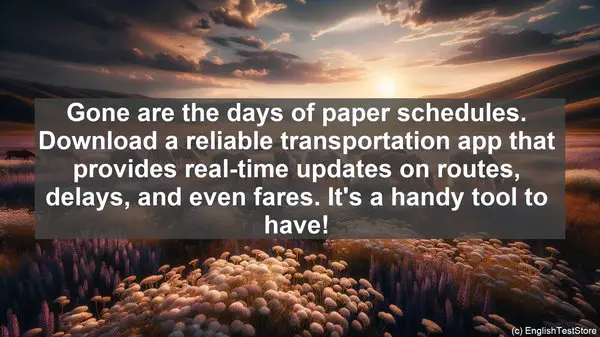Introduction
Welcome to today’s lesson. If you’re a student at the B1 level, navigating public transportation in English can be a bit challenging. But worry not! In this video, I’ll be sharing 10 tips that will make your commute a breeze. Let’s get started!
1. Familiarize Yourself with Common Terms
Public transportation has its own set of vocabulary. Take some time to learn words like ‘platform,’ ‘fare,’ and ‘transfer.’ This will help you understand signs and announcements better.
2. Use Mobile Apps for Schedules and Routes
Gone are the days of paper schedules. Download a reliable transportation app that provides real-time updates on routes, delays, and even fares. It’s a handy tool to have!
3. Pay Attention to Announcements
While on board, listen carefully to announcements. They often include important information like the next stop or any changes in the route. If you’re unsure, don’t hesitate to ask fellow passengers or the driver.
4. Master Basic Questions and Phrases
Knowing how to ask for directions or inquire about the next stop is crucial. Practice simple phrases like ‘Excuse me, is this the right platform for the downtown train?’ It’ll make communication much easier.
5. Be Mindful of Etiquette
Public transportation is a shared space. Remember to give up your seat for those in need, keep your voice down, and avoid eating or drinking unless it’s allowed. It’s all about being considerate.

6. Plan for Delays
Sometimes, delays are inevitable. If you have an important appointment, factor in extra time. Use that time to revise your English notes or catch up on a book. It’s all about making the most of it!
7. Understand Ticketing Systems
Ticketing systems can vary from city to city. Familiarize yourself with the options available, whether it’s a single ride ticket or a monthly pass. This will save you from any confusion at the ticket machine.
8. Watch Out for Transfer Points
If your journey involves multiple modes of transportation, pay attention to transfer points. These are usually mentioned in announcements or displayed on signs. Missing a transfer can lead to unnecessary detours.
9. Join Language Exchange Groups
Language exchange groups are a fantastic way to practice your English. You can meet fellow learners or native speakers who can provide insights into using English in public transportation or even offer to be your travel buddy.
10. Stay Updated with Local News
Lastly, stay informed about any changes or disruptions in the transportation system. Local news outlets or official social media accounts often provide timely updates. Being in the know is always beneficial.

